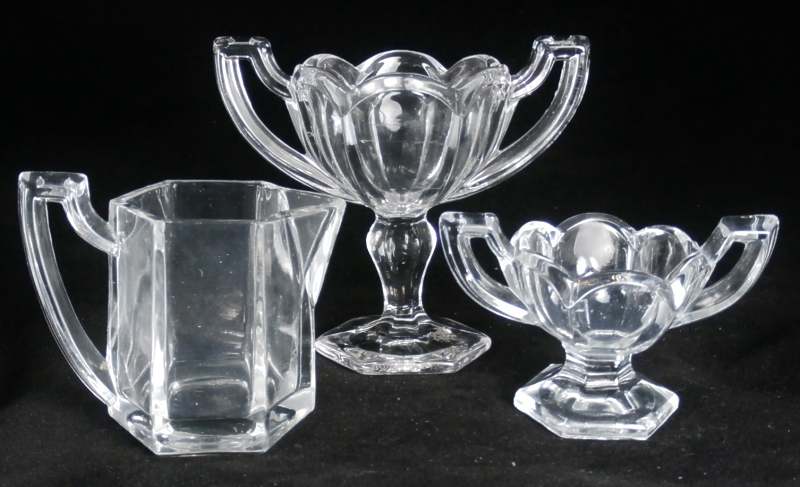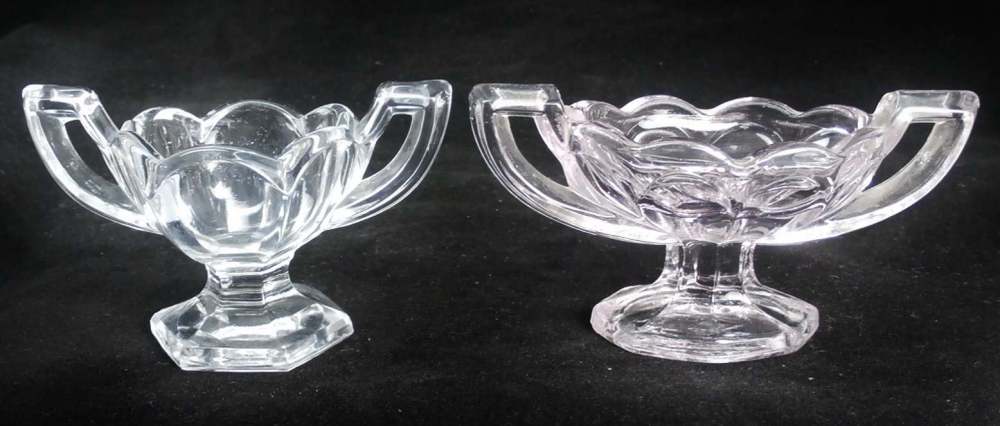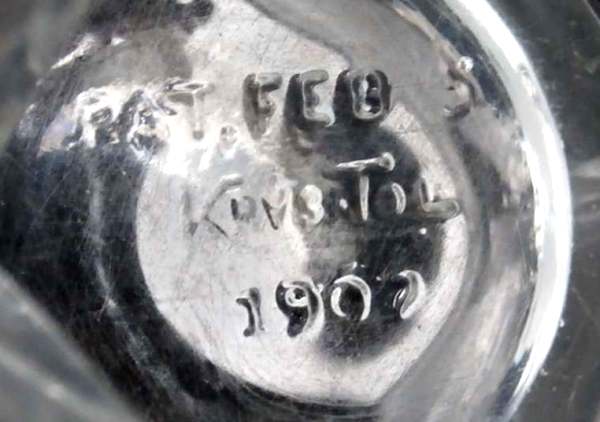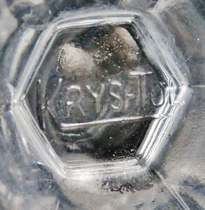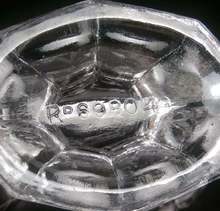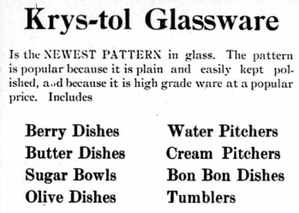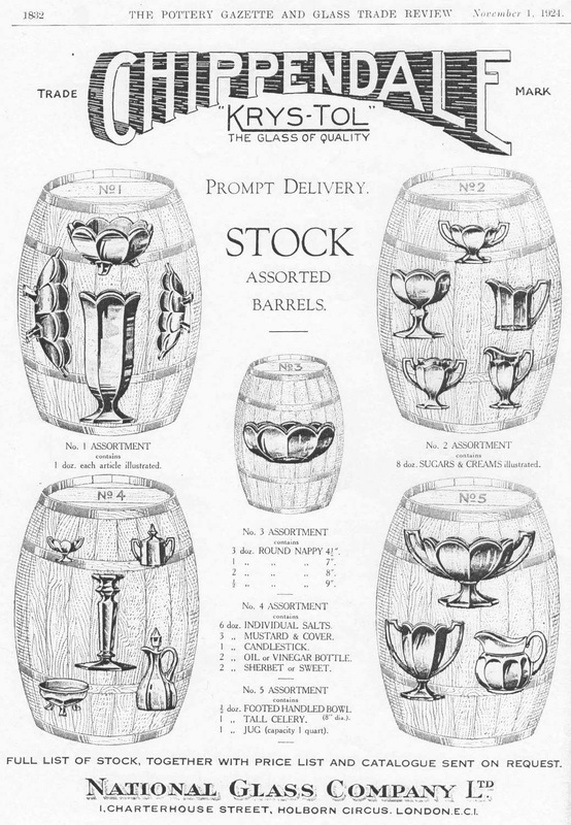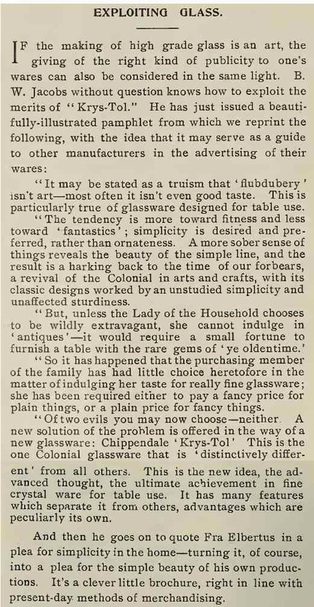It's Krys-Tol Clear!
Krys-Tol glass, elegant and sophisticated, was apparently the brainchild of Benjamin Jacobs, dating back to 1905. The glass was unusually brilliant, allegedly due to high furnace temperature and a method of finishing and polishing the glass – and the trademark Krys-Tol was given to the range of glass made this way – primarily on the familiar pattern range called “Chippendale” (although other patterns were also trademarked – the names Chippendale and Krys-Tol are inextricably intertwined).
Initially Krys-Tol glassware was made at the Ohio Flint Glass Company, and then later at The Jefferson Glass Co. of Follansbee, West Virginia, from around 1908 to 1918. Below are two early adverts for Krys-tol (sic) glassware. It's interesting to note that the North Dakota newpaper ad was offering the glass as an incentive to ladies to attend the store's sales.
For some reason in 1910, Jefferson Glass considered it necessary to take out an ad to reassure its customers that its popular range of Krys-Tol / Chippendale was not being discontinued. It was, they said "too valuable an asset to cast aside" - see below, left - and "the most popular pattern in the market."
It was also popular in the UK. The ad on the right below from the 1909 British Pottery Gazette shows the Krys-Tol range, was being imported into the UK by Charles Pratt, their UK Agent, of the National Glass Co. With its distinctive flat-topped handles, it was a leading seller, being described as "distinctly different" and "artistically superior" to other glass tableware.
It was also popular in the UK. The ad on the right below from the 1909 British Pottery Gazette shows the Krys-Tol range, was being imported into the UK by Charles Pratt, their UK Agent, of the National Glass Co. With its distinctive flat-topped handles, it was a leading seller, being described as "distinctly different" and "artistically superior" to other glass tableware.
|
We know quite a lot about Mr Charles Pratt of England! Born in 1871, he was connected with the glass industry for most of his business life, and was responsible for the widespread introduction of American pressed table glassware to the English market. Pratt founded the National Glass Co. which acted as agent for some of the foremost US glass factories, including Fenton, which is where we came across Mr Pratt and the National Glass Co. before, in connection with the importation of vast amounts of Fenton's Carnival Glass into the UK. Pratt was the sole agent in the UK for the Krys-Tol and Chippendale glassware since the early days. The British Pottery Gazette ad for 1909 has his name at the bottom, as sole agent for the "United Kingdom and Colonies". At that time, the British Colonies covered about one-fifth of the globe: Canada, Central and South America, Australiasia, Africa, India, and other parts of Asia. |
In 1918, the Krys-Tol range passed to the Central Glass Works, Wheeling, West Virginia. However the popularity of the range in the USA began to decline, but large quantities were still being sent to the UK market, as the 1924 ad below shows. It is from the Pottery Gazette, and featured a fascinating graphic of barrels, full of Chippendale Krys-Tol glass. It also shows just how extensive the range of pieces had become by then.
|
No flubdubery! Today's advertising copywriter's are not the first ones to use flamboyant language to describe their every-day items for home use. Here is an article from 1910 about the virtues of Krys-Tol glassware. It was said to reveal the simple, sober sense of (American) Colonial arts and crafts. But unlike the "wildly extravagant" antiques of "ye oldentime", the lady of the house could now indulge in Chippendale Krys-Tol - the "ultimate achievement in fine crystal ware for table use". WOW! |
Jump to 1929-1930 and cue Charles Pratt in the Krys-Tol story once again! Ever the entrepreneur, and with an eye for what would sell, Pratt had the entire Chippendale range (moulds and all) jump “The Pond” from the USA to the north-east of England in 1929-1930, where it was then made by Davidson.
Here’s the text from a 1933 British Pottery Gazette ad for Chippendale glassware:
Geo. Davidson & Co. Teams Glass Works, Gateshead-on-Tyne.
Manufacturers of the world renowned “Davidson” Glassware have pleasure in announcing that they have purchased
the Moulds, Registered Trade Mark and Sole Manufacturing rights of the well-known “CHIPPENDALE” Glassware.
This range of exquisite models is now offered at reduced prices and can be seen at the London Showrooms.
Manufacturers of the world renowned “Davidson” Glassware have pleasure in announcing that they have purchased
the Moulds, Registered Trade Mark and Sole Manufacturing rights of the well-known “CHIPPENDALE” Glassware.
This range of exquisite models is now offered at reduced prices and can be seen at the London Showrooms.
In addition to the Charles Pratt connection, there are many other interesting cross-overs into Carnival Glass.
The square-topped Chippendale style handles were copied by several makers on some of their Carnival patterns (e.g.Westmoreland’s Orphan Annie and several Riihimaki and Brockwitz items). Indeed, an early USA Chippendale hair receiver shape was later made by Eda Glasbruk where it was actually called Chippendale Bonbonier (and it is possible the original mould was used).
The square-topped Chippendale style handles were copied by several makers on some of their Carnival patterns (e.g.Westmoreland’s Orphan Annie and several Riihimaki and Brockwitz items). Indeed, an early USA Chippendale hair receiver shape was later made by Eda Glasbruk where it was actually called Chippendale Bonbonier (and it is possible the original mould was used).
